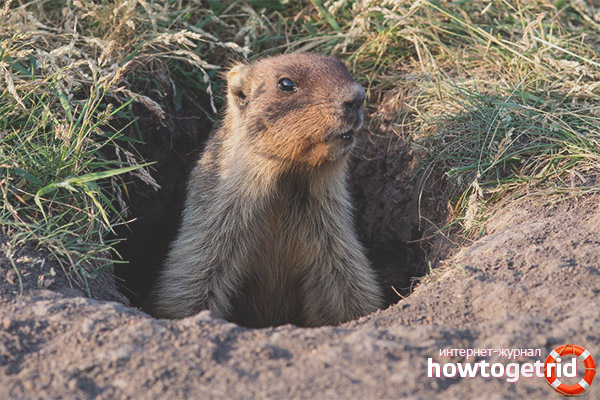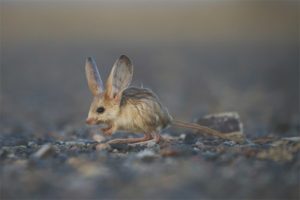The content of the article
Baibak, or Babak, also known as common groundhog, is a mammal belonging to the order of rodents Rodentia, which includes squirrels, gophers, chipmunks and others.
Description
A small, squat animal with a flattened head. The baibak weighs 3-8 kg (sometimes the weight can reach up to 15 kg). Body length is 40-65 cm, including a short, fluffy tail about 15 cm long. The color of the fur depends on the region, ranging from tan to reddish brown, with an average brown color being the most common shade.
Some individuals have melanism or albinism. In the first case, rodents are completely black, in the second - completely white with eyes lacking pigmentation, the pinkish tint of which is due to blood vessels located on the surface. Because of their brilliant whiteness, albinos are easy prey for their enemies.
As a digging animal, the baibak has strong, strong legs with strong claws. For digging, they use the front legs, which are armed with four specially developed claws, while the hind legs have five ordinary claws. As a rule, the animal hides from its enemies in the hole, since the speed of the baibak is not very high.
The rodent's vision is excellent (although some researchers believe that he sees worse than humans). In particular, its viewing angle is very wide. Also, the baibak can see some colors. But he is poorly oriented in the dark, twilight vision is poor, so the rodent almost never leaves the hole at night. He has excellent hearing and a very well-developed sense of smell.
Behavior
Baibak is very sociable, lives in small colonies of a matriarchal type. The family group consists of 5-12 people. In one hole - one family. This is a strictly daytime animal, which is rare in wild mammals. The baibak rises early, before sunrise, and in the morning takes its first meal. Then he slumbers for about 10 hours, spread out on an elevation, but always alert, with his eyes open. He is in his hole in the hot hours of the day to sleep peacefully, between 12 and 15 hours. Then he takes a second meal and goes to bed an hour before dark.
Baibak is very cautious and suspicious. She usually stands on her hind legs to better control the terrain. The animal begins to hiss in case of danger, and this sound can be heard at a distance of up to 1 km. As soon as they emit a characteristic cry about imminent danger, immediately all the relatives hide in the nearest burrows. The passage of an eagle can cause a very strong panic attack and, accordingly, rodents will loudly report it. Baibaki are curious animals and love to play. They sometimes play among themselves, usually in pairs.
Habitat and habits
Baibak tries to avoid wet or swampy areas. It prefers open spaces such as fields, clearings, rare forests and rocky slopes. Usually he digs his hole in places where he can eat abundantly with plants.
In summer, his hole is located in the middle of pastures or meadows, as a rule, only in winter does he settle in groves or undergrowth.The winter hole, regardless of whether it is isolated or not, is usually deep enough, because the deeper the hole, the easier it will be to bear the winter.
The mink has a main entrance, one or more inspection pits to increase security, as well as a toilet and sockets in different places. The nest, which is used for recreation, wintering and rearing of young animals, is lined with dry grass and has a width of about half a meter and a height of more than 30 cm.
Out of periods of hibernation or caring for cubs, the baibk spends most of its time eating and basking in the sun. He likes to bask in warm land, on smooth rocks or on low branches.
Towards the end of summer, when hibernation is approaching (long winter sleep), the individual begins to gain fat. It starts as soon as frost sets in. Young individuals need a little more time to gain enough fat for the whole winter. Hibernation begins at the end of September, individual baibaki already in this period begin to lie in it. Until October, usually all animals are already in hibernation. At this moment, the rodent is in a state of very unreliable physiological equilibrium, which can at any moment pass into death.
Hibernation is a kind of deep coma. All body functions are significantly slowed down, so the accumulated fat is enough to feed the animal all winter. Its temperature can drop to + 3C, and the heartbeat can drop from the usual 80 to as little as four or five beats per minute. Respiratory rate is reduced, and therefore oxygen consumption is greatly reduced. When the animal leaves the hole in the spring, it still has a certain amount of fat that it needs, since food is still not enough in March.
Like all wintering mammals, the baibak is subject to awakening. Heart rate, respiratory rate and thermogenesis increase to almost normal values. In fact, these periods are critical for rodents. During these periods of awakening, which make up only 5% of the total duration of the animal’s presence in hibernation, the baibak spends 90% of its energy reserves. However, these phases of awakening are vital to mammals. They are necessary to maintain energy-intensive support functions that require high internal temperatures.
Nutrition

Baibak is omnivorous, but its diet consists mainly of fresh vegetation. He consumes a large variety of wild plants, clover, alfalfa, compound, flowers, buds, bulbs, as well as vegetables and seeds when he finds them. In rare cases, he eats random snails, earthworms, larvae and insects (grasshoppers and locusts). In early spring, it feeds on bark and small branches of shrubs. It consumes about 400 g of grass in one meal. This is 100 kg for 6 months of summer activity. The rodent uses its tenacious paws to take apart food.
Breeding
Cubs are usually born in April or May after a 30-day pregnancy. Baibak has one litter per year, with an average of four cubs. Blind and defenseless at birth, the cubs are about 10 cm long and weigh almost 30 g. After 28 days, their eyes open and their body is covered with short hair. They are weaned from the fifth to sixth week, and already at this time they begin to leave the hole. Growth is so fast that they weigh 570 grams in eight weeks and become very thick for hibernation. Some baybak live up to 15 years, but their average life expectancy is still less.
Dangers and sabotage
The most effective way to protect against predator attacks is the sight of this animal. In addition to the fact that these animals have good vision, they also have a wide viewing angle of 300 ° (in humans 160 °), so it is very difficult to catch them by surprise. It is worth noting that the sense of smell and hearing are also very well developed in this rodent. They act as additional protection against a surprise attack.
Many farmers consider a baibak to be a pest because of the plants that it eats, and because of the heap of soil that it accumulates while digging its hole. To a certain extent, the baibak competes with cattle for food and occasionally raids gardens. However, the belief that the baibak is an animal pest is still largely erroneous.
Video: Marmota bobak











Submit